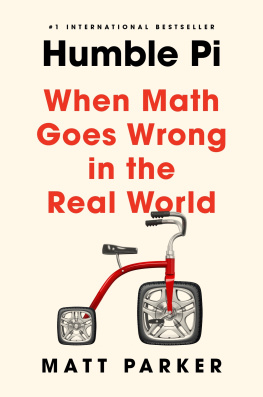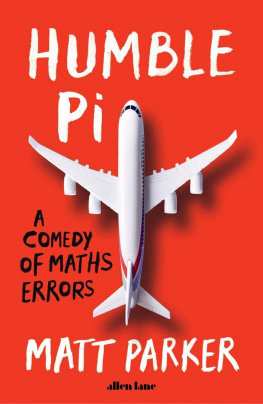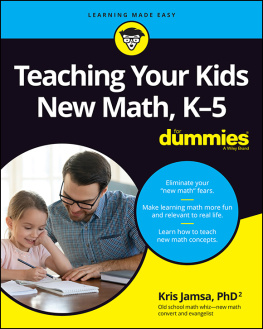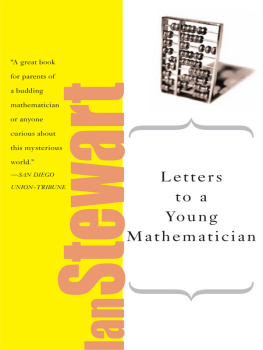
The author and publisher have provided this e-book to you for your personal use only. You may not make this e-book publicly available in any way. Copyright infringement is against the law. If you believe the copy of this e-book you are reading infringes on the authors copyright, please notify the publisher at: us.macmillanusa.com/piracy.
Dedicated to Keith and Nona Pallot, my maternal grandparents, who inspired me to make and teach
Contents
n + 1
Zero
Have a look around you and find a drinking vessel, like a pint glass or a coffee mug. Despite appearances, almost certainly the distance around the glass will be greater than its height. Something like a pint glass may look like it is definitely taller than it is round, but a standard UK pint glass is actually around 1.8 times greater in circumference than in height. A standard tall takeaway cup from omnipresent high-street coffee shop Starbucks is actually 2.3 times further around, but yet they refuse my requests to rename it the squat.
Using this to your advantage is easy enough: when you are next drinking in a pub, caf or whichever drinking establishment serves the sort of beverages you enjoy getting for free, bet someone that their drinking vessel is further around than it is high. If there is a pot beer glass (the ones with handles) in the pub, or an obscenely large mug in the caf, then youre sorted: they are typically three times as far around as they are tall, so you can dramatically stack three of them and claim it is still further around than up. Producing a tape measure at this point may cause your victims to question the spontaneity of the whole exercise, so use a nearby straw, or its protective paper sleeve, as a makeshift ruler.
This works for all glasses, except for only the skinniest of champagne flutes. If youd like to subtly check your drinking glass without arousing suspicion, try to wrap your hand all the way around it. Your fingers and thumb will not meet on the other side. Now, with your thumb and index finger, try to span the height of the glass. You will most likely succeed (or, at worst, come very close). This is a dramatic demonstration of how much shorter glasses are than they are around.
This is exactly the sort of maths I wish more people knew about: the surprising, the unexpected and, most importantly, the type that wins you free drinks. My goal in this book is to show people all the fun bits of mathematics. Its a shame that most people think maths is just what they were subjected to at secondary school: it is so much more than that.
In the wrong situation, maths can indeed border on the tedious. Walk into a school at random in search of a maths class, and youll most likely find a room where the majority of the students are not excited. In the least. You will shortly be asked to leave the premises, and the police may even be called. Youre probably on some kind of list now. The point is, those students in the classroom are following in a long line of generation after generation of uninspired maths students. But there will be a few exceptions. Some of them will be loving maths and will go on to be mathematicians for the rest of their lives. What is it that theyre enjoying which everyone else is missing?
I was one of those students: I could see through the tedious exercises to the heart of maths, the logic behind it all. But I could sympathize with my fellow students, and specifically, the sporty ones. At school, I dreaded football drills in the same way that other people dreaded maths class. But I could see the purpose of all that messing around dribbling a football between traffic cones: youre building up a basic repertoire of skills so that youre better when it comes to an actual game of football. By the same token, I had an insight into why my sporty classmates hated maths: its counterproductive to make pupils practise the basic skills needed for maths but then not let them loose into the field of mathematics to have a play around.
That is what the maths kids knew. This is why people can make a career out of being a mathematician. If someone works in maths research, theyre not simply doing harder and harder sums, or longer divisions, as people imagine. That would be like a professional footballer merely getting faster at dribbling up the field. A professional mathematician is using the skills theyve learned and the techniques theyve honed to explore the field of mathematics and discover new things. They might be hunting for shapes in higher dimensions, trying to find new types of numbers, or exploring a world beyond infinity. They are not just practising arithmetic.
Herein lies the secret of mathematics: its one big game. Professional mathematicians are playing. This is the goal of this book: to open up this world and give you the freedom to play with maths. You too can feel like a premier-league mathematician, and if you were already one of those kids who embraced maths, there are still plenty of new things to discover. Everything here starts with things you can really make and do. You can build a 4D object, you can dissect counter-intuitive shapes and you can tie unbelievable knots. A book is also an amazing piece of technology with a state-of-the-art pause function. If you do want to stop and play around with a bit of maths for a while, you can. The book will sit here, the words static on the page, waiting for you to return.
All the most exciting bits of cutting-edge technology are mathematical at heart, from the number-crunching behind modern medicine to the equations that help carry text messages between mobile phones. But even technology which relies on bespoke mathematical techniques still ultimately rests on mathematics that was originally developed because a mathematician thought it would be fun to try to solve a puzzle.
This is the essence of mathematics. It is the pursuit of pattern and logic for their own sake; it is sating our playful curiosity. New mathematical discoveries may have countless practical applications and we may owe our lives to them but thats rarely why they were discovered in the first place. As the Nobel Prize-winning physicist Richard Feynman allegedly said of his own subject: Physics is a lot like sex; sure it has a practical use, but thats not why we do it.
I also hope to bring the maths you did learn at school into focus. Without it, all the other interesting bits of maths would not be within reach. Every student has vague memories of learning about the mathematical constant pi (roughly equal to 3.14), and some may recall that it is the ratio of the diameter to the circumference of a circle. It is because of pi that we know the distance around a glass is over three times greater than the distance across it. And it is the distance across which most people use when judging how big a glass is, forgetting to multiply by pi. This is more than memorizing a ratio, this is taking it for a test-run in the real world. Sadly, very little school maths focuses on how to win free drinks in a pub.
The reason that school maths cannot be completely dismissed is that the more exciting bits of mathematics rest on the less exciting bits. This is partly why some people think maths is so hard: theyve missed a few vital steps along the way, and without them the higher ideas seem impossibly out of reach. But if they had tackled the subject one step at a time, in the correct order, it would have been fine.
No one bit of mathematics is that hard to master, but sometimes its important that you do things in the optimal order. Sure, getting to the top of a very high ladder may take a lot of effort from start to finish, but each individual rung is no more work to reach than the last one was. Its the same with mathematics. Step by step, its great fun. If you understand prime numbers, then exploring prime knots is much easier. If you get to grips with 3D shapes first, then 4D shapes are not that intimidating. You can imagine all the chapters in this book as a structure, where each one rests upon several of the previous chapters.
Next page






